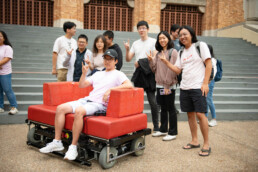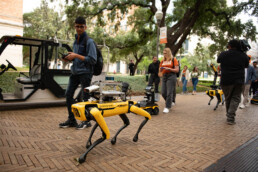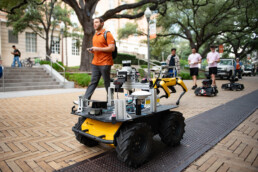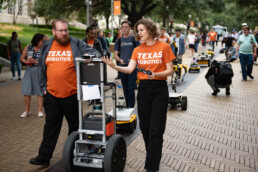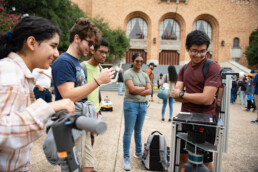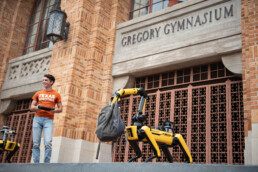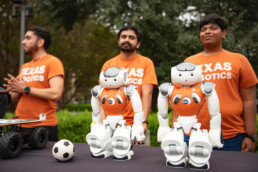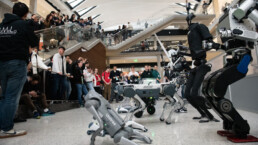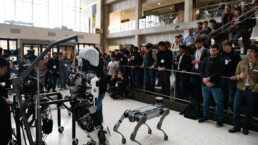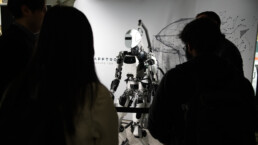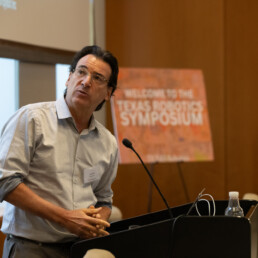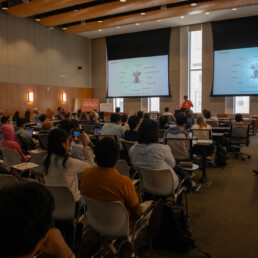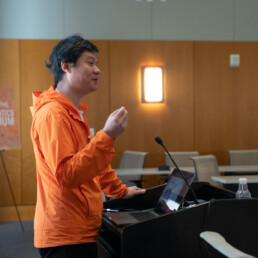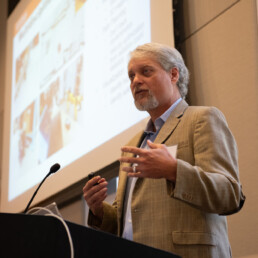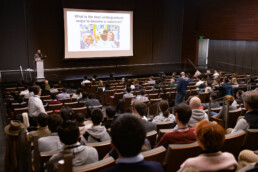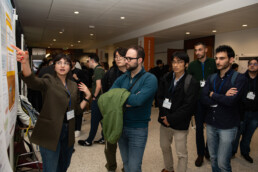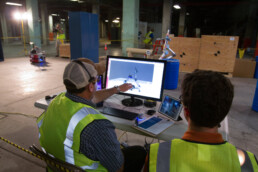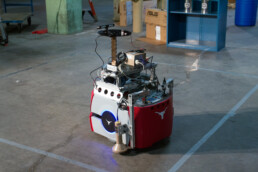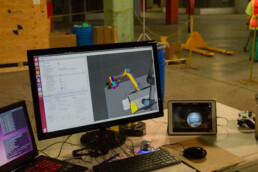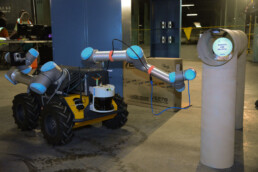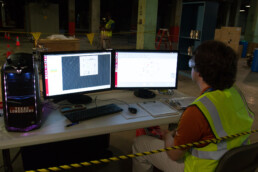by persephonie cole
It’s a bird! It’s a plane! It’s a … couch? A red cloth couch propelling itself forward on an impressive amount of circuitry, shopping cart wheels and willpower, no less. This was the last robot in the robot parade that took over Speedway, but the first one I saw as I rounded the corner chasing down the march of the machines.
Upon rejoining the melee, it was clear that both students and staff were confused and delighted by the robots rolling and driving down Speedway. Several onlookers paused to snap photos or simply to take in the sights. The slow procession of high-tech machines allowed some students to jump into the fray and ask questions about their favorite robots as they walked.
Once the robo-cade made its way to the Gregory Gym, it was time for a series of demonstrations showing off what these talented UT engineers and computer scientists made. One student, seeing the Boston Dynamics-made Spot robot said, “They’re like robot dogs. I wonder what other things we find in nature that we could make robot counterparts of.”
Students climbed the steps of the Gregory Gym to get a better look at the ambulatory robots as they were presented to the crowd before moving to individual booths to glimpse robot prosthetics, gliders, UT’s own robot soccer team and more. The kinds of robots from Texas Robotics are widely varied and discussing their uses and implications with the faculty and industry partners is a highlight on the Forty Acres.
It’s no secret that UT has become a hub for robotics, with the growth of Texas Robotics in recent years, the addition of a robotics minor and research that has gained global attention.
“At Texas Robotics, we bring together some of the best robotics researchers in the world to develop solutions that will enable us to accomplish groundbreaking things. These events show the world everything we’re doing here at UT to improve the field of robotics and educate the next generation of leaders.”
— Peter Stone, professor, Computer Science Department, College of Natural Sciences; and director, Texas Robotics
Humanoid Nature
But the robots don’t always parade around campus; sometimes they fill buildings like the Engineering Education and Research Center. And they don’t always look like dogs or couches; they resemble humans, most of them anyway.
The emphasis on real-world applications shows the potential for robots to impact our lives sooner rather than later.
“At UT, we’re pioneering human-robot interaction and researching new ways for robots to help us in our daily lives.”
— Luis Sentis, professor, Department of Aerospace Engineering and Engineering Mechanics, chair of Humanoid Conference and co-founder of humanoid robotics company Apptronik
During one demonstration, a fleet of human-like robots linger around the perimeter, hanging from chains as they await their moment. In the center, a long walkway and several boxes represent obstacles. The robots take turns traversing the path and avoiding the obstacles, as part of a race to see which company’s robots can do it the fastest. Elsewhere in the room, dog-shaped robots bound up the EER staircase to a combination of entertainment and trepidation from the students and other spectators seated on nearby steps.
Apptronik’s humanoid robot waves at the crowd at a Humanoid conference.
Things don’t always go according to plan. One robot lost a critical piece after taking a hard hit during a competition.
But luckily, Zarko Vukovich, building manager of the Anna Hiss Gym where much of the robotics work at UT happens, was on the case. A known problem-solver on campus, Vukovich got the call about the busted part and turned to Tim Hooper, a technical services manager from the College of Natural Sciences’ Department of Chemistry for help. Within 24 hours, they had a fix.
“It feels like being a field mechanic,” he said.
Learning Human Behavior
A lively discussion of robotics projects.
In addition to the robotic competitions, UT Austin hosts robotics conferences, often involving days of technical talks and presentation of papers from academic researchers and robot companies all over the world. These papers touch on almost every aspect of robotics, from the algorithms that serve as their brainpower, to the physical construction of the robot, to their performance of tasks, to how people interact with them and more.
They cover a wide variety of subjects, including generating motion, robots working with humans on tasks, performing tasks in very tight spaces while making contact with unknown objects, training robots to do things based on demonstrations from humans, and quickly adjusting the path of a walking robot to avoid unknown obstacles.
UT Austin also shows the diversity of robots under development by groups around the world. We saw robots that looked very much like people, and others that didn’t. Some had more than two legs. Others had particular parts enhanced for certain tasks.
UT Austin visitors had a chance to try out cutting-edge robotic technology like these robot arms.
For example, one paper from researchers at Kyushu University in Japan, focuses on the feet of robots, specifically dynamic movement and shock absorption. They attempted to train robots to play sports such as football, badminton and soccer. Athletic movements like these are, understandably, far harder for robots to master than taking a step or two or even climbing stairs.
Motion is often a major theme in robotics research. Because of the expectation and potential of humanoid robots – which could serve as everything from home help aids, to contaminated site cleanup instruments, to warehouse helpers – getting motion right is key to their success.
Think about all the fine motor skills humans possess. Something like grasping a knife and fork and cutting food, handing something to someone else, pouring water into a cup, or picking up small objects in a variety of shapes is second-nature to us. But it takes a lot of work to design and program robots to do these things.
“The complexity of the human body is huge. How we deal with this complexity and master the challenge of motion generation is critical to our field.”
— Tamim Asfour, professor, Institute for Anthropomatics and Robotics, Karlsruhe Institute of Technology in Germany
Texas Robotics
A recent Texas Robotics Symposium featured a variety of speakers from across UT and industry partners, including aerospace engineer Luis Sentis (top left); Jie Tan, a senior staff research scientist from Google (bottom left); and mechanical engineer Mitch Pryor (bottom right).
Texas Robotics, an interdisciplinary program that brings together faculty from across the Forty Acres – including the Department of Aerospace Engineering and Engineering Mechanics, the Chandra Family Department of Electrical and Computer Engineering, the Department of Computer Science and the Walker Department of Mechanical Engineering – has played an important role in Robotics momentum at UT. The program brings together nearly 60 core and affiliate faculty members – more than half come from the Cockrell School – and about 200 students.
A recent Robotics Symposium included UT Austin faculty and industry partners who are on the cutting edge of robotics research and development. There was something for everyone – whether it was a lecture on robot dogs, the latest in medical robotics, or anything in between.
Robotics and Education
UT offers an undergraduate minor in robotics for students majoring in a related field. Students can also apply for undergraduate research programs in robotics or join one of several robotics student organizations to immerse themselves in the growing, interdisciplinary field.
Nuclear and Applied Robotics
If you’ve seen the movie Oppenheimer, you may be unsurprised to learn that radiation detection is still needed at old nuclear testing sites, like that of Los Alamos. Mitch Pryor, a senior research scientist in the Walker Department of Mechanical Engineering, collaborates with other scientists on projects like these where robots are particularly helpful in detecting radiation. One such machine is being trained to “clean as it goes” by lifting obstructions out of the way. It can even interact with its environment with an amount of situational awareness based on algorithms and lab simulations.
But what about obstructions in our bodies? As mechanical engineering faculty member Ann Majewicz Fey points out, the third leading cause of death in health care is human error, behind cancer and heart disease. Robots can help with that.
The ability to perform surgeries faster, with more precision, and quickly and accurately diagnose illnesses, show the benefits robots can offer. One of the key areas robotics can make a huge difference is in the training tools that surgeons use.
“A lot of hospitals invest in high-end surgical training rooms that are often empty; surgeons prefer hands-on training which isn’t always ideal for the patient,” says Majewicz Fey.
The next frontier of medical training could very well be robots as tools that are continually improved with passive and active restraints, telemonitoring, even haptic feedback to train surgeons on bimanual dexterity.
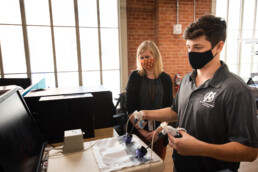
A SILICONE STOPPER, created by Ann Majewicz Fey and her team TELLS THE USER WHEN THEY ARE OVERGRIPPING a surgical INSTRUMENT.
As the future of robotics continues to develop and propel our society forward, the next generation of engineers will be taking up a prestigious mantle. Society grows and adapts, and so must the ways we use robotics to enhance our lives.
“We have to create holistically – otherwise we can create a lovely engineering piece that no one is going to use.”
— Farshid Alambeigi, professor, Walker Department of Mechanical Engineering; and leader, Advanced Robotic Technologies for Surgery lab
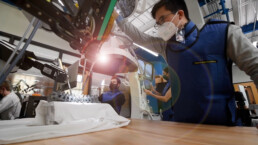
UT researchers collaborate on robotics projects in many different areas, and one strong point is “surgineering,” which combines surgical and engineering research.
Whether it’s the latest robotic prosthetic or the UT robot soccer team, it’s clear that the future of robotics starts here.
